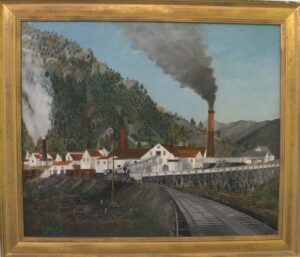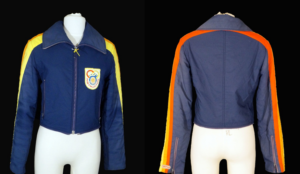In late 1959, Ernest Hemingway received a series of German press reviews from his publisher in Hamburg, Germany, Rowohlt Verlag GmbH. The press compilation starring Hemingway came from widely different publications across Germany, from mainstream newspapers in Berlin to small school newspapers in München. In a time before the internet and easier global promotion, Hemingway’s figure loomed large as one of the 20th century’s most renowned literary figures. They reveal the conversations happening … [Read more...] about Hemingway Press Reviews
Collection Highlights-History
Ketchum’s Industrial Past: The Philadelphia Smelter
The Wood River Valley is best known today for its outdoor recreation and scenic beauty, but in the late 1800s, its mountains buzzed with industry. A newly acquired painting at the Wood River Museum of History and Culture offers a rare visual record of that era: a detailed 19th-century depiction of the Philadelphia Smelter, once located at the mouth of Warm Springs Canyon in Ketchum. The painting likely dates to the 1880s and illustrates a moment of booming silver industry in the Wood River … [Read more...] about Ketchum’s Industrial Past: The Philadelphia Smelter
Chinese Liquor Bottle
Among the artifacts on display in Tracks & Traces: Reconstructing Chinese History in Southern Idaho is a ceramic liquor bottle, a remnant of the global trade networks that connected China to the United States in the early 20th century. Produced in the 1930s by the renowned Chinese distillery Wing Lee Wai, this bottle once held Ng Ka Pi—a potent variety of baijiu (“white spirit”) infused with the medicinal herb Wu Jia Pi. The distillery Wing Lee Wai, which translates to “eternal fortune … [Read more...] about Chinese Liquor Bottle
Sun Valley Ski School Instructor Jacket
As ski season takes off, we’re highlighting a unique piece from the Wood River Museum of History & Culture’s collection: a Sun Valley Ski School Instructor jacket, likely dating from the late 1960s to early 1970s. This navy blue jacket is adorned with striking yellow, orange, and red stripes that stretch from wrist to shoulder, each stripe about an inch wide. A patch proudly displaying “Sun Valley Instructor” is stitched onto the front left side, and the interior tag reads “Sport Alm; Made … [Read more...] about Sun Valley Ski School Instructor Jacket
The Reidy Memorial Cross-Country Race
In March 1972 the first annual Reidy Memorial Cross-Country Race set off. But in comparison to the very competitive and professional racing Sun Valley is known for, the Reidy Memorial was anything but. Skiers of all skill levels and ages were invited to race, dress up, and have a good time. The race was started by Barbara and Jamie Reidy in memory of Lynn Reidy, who tragically passed away in an accident at twenty-five years old. Barbara, Lynn’s mother, and Jamie, Lynn’s sister, decided that … [Read more...] about The Reidy Memorial Cross-Country Race
The Blaine County Fair Horse-Pull
This dramatic photo, taken at the Blaine County Fair in 1983, shows the incredible power of a team of horses competing in the horse-pull event. In this event, individual horses or teams compete to see which can drag the most weight over a pre-determined distance. The event has its roots in friendly competitions between farmers with their draft horses, but these days horses are trained specifically for the horse-pull event, and typically are not involved in regular farm work. Teams take turns … [Read more...] about The Blaine County Fair Horse-Pull



